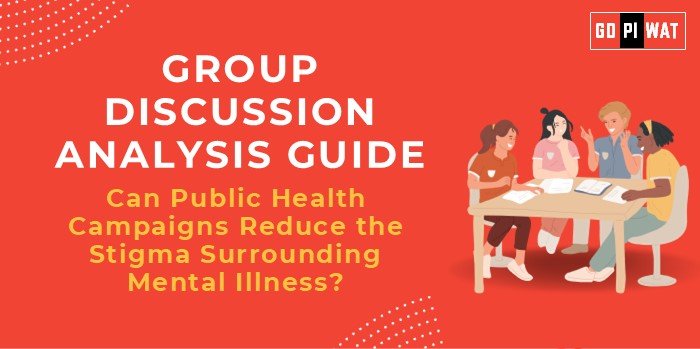📋 Group Discussion Analysis Guide: Can Public Health Campaigns Reduce the Stigma Surrounding Mental Illness?
🌐 Introduction to the Topic
Context Setting:
Mental illness affects millions worldwide, yet stigma remains a significant barrier to treatment. Public health campaigns have emerged as vital tools to change perceptions and promote inclusivity.
Topic Background:
Historically, mental illness was surrounded by misinformation and social taboos. Campaigns like WHO’s “Depression: Let’s Talk” and India’s MindYourMind initiative focus on breaking stereotypes through education and visibility. As mental health becomes a policy priority, analyzing the effectiveness of these campaigns is crucial for society and business leaders.
📊 Quick Facts and Key Statistics
- 🌍 Global Prevalence: 1 in 8 people live with a mental health condition (WHO, 2023).
- 💵 Economic Cost: Mental health issues cost $1 trillion annually in lost productivity (Lancet, 2022).
- 🇮🇳 India’s Mental Health Burden: 197 million Indians suffer from mental disorders, yet 85% lack access to care (Lancet, 2023).
- 📈 Campaign Impact: BellLetsTalk raised $121 million for mental health awareness in Canada since 2010.
🔍 Stakeholders and Their Roles
- Governments: Fund initiatives and integrate mental health into healthcare policies.
- NGOs and Activists: Conduct grassroots campaigns and community engagement.
- Media and Corporations: Amplify messages, fund campaigns, and create stigma-free workplaces.
- Healthcare Providers: Offer education, diagnosis, and treatment through outreach programs.
🏆 Achievements and Challenges
Achievements:
- 📣 Increased Awareness: Campaigns like MentalHealthMatters have boosted social discussions.
- 🩺 Policy Inclusion: Nations like New Zealand integrate mental health in primary healthcare.
- 🏢 Corporate Initiatives: Companies such as Tata Steel have employee wellness programs.
Challenges:
- ⚠️ Cultural Barriers: Social stigma remains high in rural and conservative communities.
- 💰 Resource Scarcity: Low funding and workforce shortages hinder campaign outreach.
- 🌐 Global Disparities: High-income countries dominate mental health initiatives, leaving low-income regions behind.
Global Comparisons:
Success: Canada’s BellLetsTalk effectively funds programs through high engagement.
Challenges: Nigeria faces low campaign funding and public resistance due to misinformation.
Case Studies:
Kerala, India: Launched a mental health helpline with strong regional success in destigmatization.
💬 Structured Arguments for Discussion
- Supporting Stance: “Public health campaigns such as WHO’s EndTheStigma have transformed global conversations about mental health, reducing barriers to treatment.”
- Opposing Stance: “Campaigns alone cannot address the deep-rooted stigma fueled by cultural taboos and systemic neglect.”
- Balanced Perspective: “Public health campaigns are critical for raising awareness but require systemic reforms and local adaptations to succeed.”
💡 Effective Discussion Approaches
- Opening Techniques:
- 📈 Statistical Hook: “With nearly 200 million Indians affected, mental health needs urgent destigmatization.”
- 📜 Story-Based: Share a brief case study, e.g., Kerala’s helpline success.
- Counter-Argument Handling:
- Use data (e.g., campaign effectiveness) to counter skepticism.
- Highlight synergies between public awareness and policy reforms.
🔍 Strategic Analysis of Strengths and Weaknesses
- Strengths: Growing global focus; increasing engagement through social media.
- Weaknesses: Limited rural outreach; over-reliance on urban-centric media.
- Opportunities: Leverage AI for targeted campaigns; partner with corporates for funding.
- Threats: Risk of misinformation through unregulated online platforms.
📚 Connecting with B-School Applications
- Real-World Applications: Use in social entrepreneurship projects or corporate wellness initiatives.
- Sample Questions:
- 🧐 “How would you design a campaign to destigmatize mental health in rural areas?”
- 🤖 “What role can AI play in addressing mental health stigma?”
- Insights for Students:
- Focus on mental health’s impact on workplace productivity.
- Explore global partnerships for health innovations.


